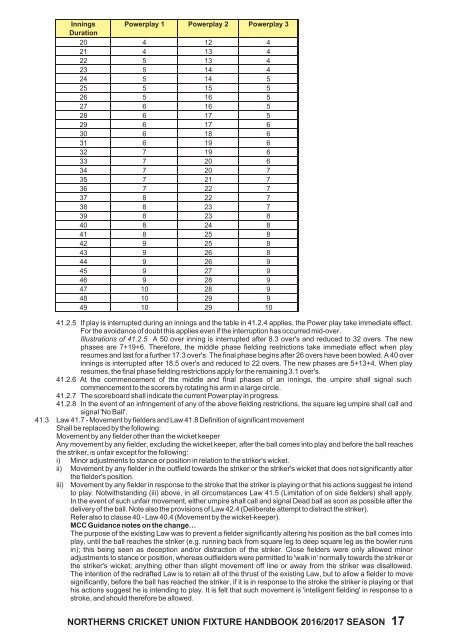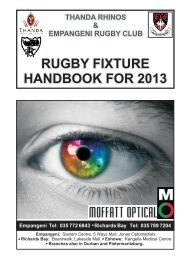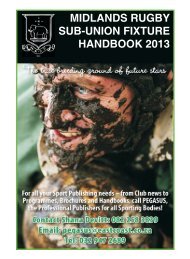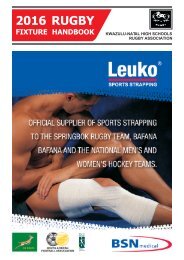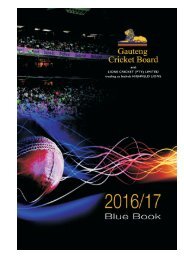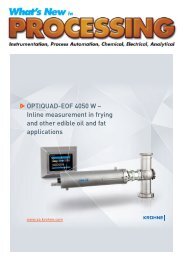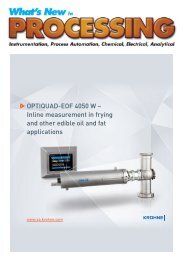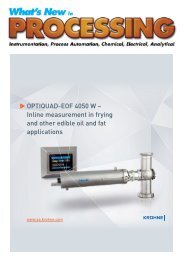Create successful ePaper yourself
Turn your PDF publications into a flip-book with our unique Google optimized e-Paper software.
41.2.5 If play is interrupted during an innings and the table in 41.2.4 applies, the Power play take immediate effect.<br />
For the avoidance of doubt this applies even if the interruption has occurred mid-over.<br />
Illustrations of 41.2.5 A 50 over inning is interrupted after 8.3 over's and reduced to 32 overs. The new<br />
phases are 7+19+6. Therefore, the middle phase fielding restrictions take immediate effect when play<br />
resumes and last for a further 17.3 over's. The final phase begins after 26 overs have been bowled. A 40 over<br />
innings is interrupted after 18.5 over's and reduced to 22 overs. The new phases are 5+13+4. When play<br />
resumes, the final phase fielding restrictions apply for the remaining 3.1 over's.<br />
41.2.6 At the commencement of the middle and final phases of an innings, the umpire shall signal such<br />
commencement to the scorers by rotating his arm in a large circle.<br />
41.2.7 The scoreboard shall indicate the current Power play in progress.<br />
41.2.8 In the event of an infringement of any of the above fielding restrictions, the square leg umpire shall call and<br />
signal 'No Ball'.<br />
41.3 Law 41.7 - Movement by fielders and Law 41.8 Definition of significant movement<br />
Shall be replaced by the following:<br />
Movement by any fielder other than the wicket keeper<br />
Any movement by any fielder, excluding the wicket keeper, after the ball comes into play and before the ball reaches<br />
the striker, is unfair except for the following:<br />
i) Minor adjustments to stance or position in relation to the striker's wicket.<br />
ii) Movement by any fielder in the outfield towards the striker or the striker's wicket that does not significantly alter<br />
the fielder's position.<br />
iii) Movement by any fielder in response to the stroke that the striker is playing or that his actions suggest he intend<br />
to play. Notwithstanding (iii) above, in all circumstances Law 41.5 (Limitation of on side fielders) shall apply.<br />
In the event of such unfair movement, either umpire shall call and signal Dead ball as soon as possible after the<br />
delivery of the ball. Note also the provisions of Law 42.4 (Deliberate attempt to distract the striker).<br />
Refer also to clause 40 - Law 40.4 (Movement by the wicket-keeper).<br />
MCC Guidance notes on the change…<br />
The purpose of the existing Law was to prevent a fielder significantly altering his position as the ball comes into<br />
play, until the ball reaches the striker (e.g. running back from square leg to deep square leg as the bowler runs<br />
in); this being seen as deception and/or distraction of the striker. Close fielders were only allowed minor<br />
adjustments to stance or position, whereas outfielders were permitted to 'walk in' normally towards the striker or<br />
the striker's wicket; anything other than slight movement off line or away from the striker was disallowed.<br />
The intention of the redrafted Law is to retain all of the thrust of the existing Law, but to allow a fielder to move<br />
significantly, before the ball has reached the striker, if it is in response to the stroke the striker is playing or that<br />
his actions suggest he is intending to play. It is felt that such movement is 'intelligent fielding' in response to a<br />
stroke, and should therefore be allowed.<br />
NORTHERNS CRICKET UNION FIXTURE HANDBOOK 2016/<strong>2017</strong> SEASON 17


